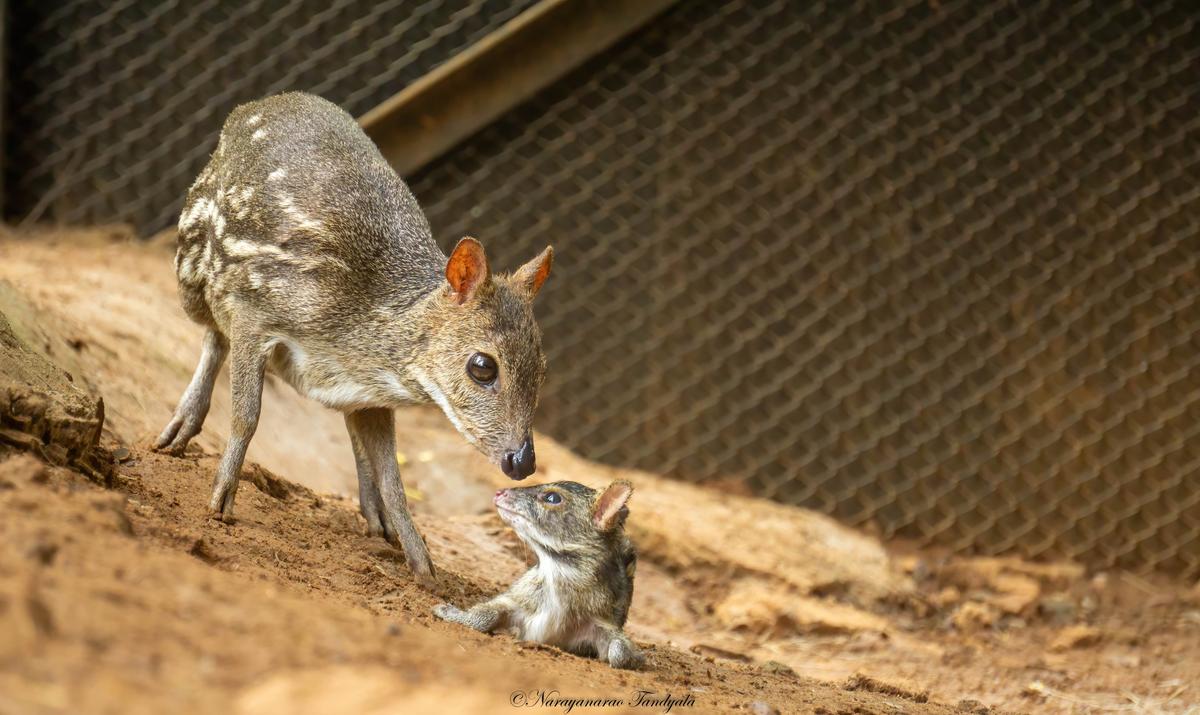
A red-necked wallaby joey peeking out of the pouch of its mother in its enclosure in Indira Gandhi Zoological Park.
| Photo Credit: SPECIAL ARRANGEMENT
There’s new life hopping and tiptoeing through the green enclosures of Indira Gandhi Zoological Park in Visakhapatnam. Two tiny additions, a red-necked wallaby joey and a newborn mouse deer, are drawing awe and admiration from the zoo staff.
Settled safely in her mother’s pouch, the red-necked wallaby joey peeks out occasionally, its miniature ears twitching and dark eyes taking in the world. Born the size of a jellybean after a 30-day gestation period, the joey made its way unaided from its mother’s birth canal to the pouch, a journey that is critical to its survival.
“We were surprised to see a tiny nose appear out of the pouch a few days ago,” says G Mangamma, curator of the Indira Gandhi Zoological Park. “The wallaby breeding programme has been a success here, and this joey marks another milestone for us.”
Red-necked wallabies are native to Australia, but have adapted well to the conditions in the Visakhapatnam zoo after they were brought a year ago in an animal-exchange programme. “What makes their reproductive system unique is the mother’s ability to nurse three young at different stages of development, an embryo in pause, a pouch joey, and a larger suckling joey who has ventured outside the pouch. Each teat produces milk with a distinct nutritional profile, tailored to the specific needs of each offspring,” explains Dr Bhanu, the zoo’s veterinarian, and adds, “It’s an incredible biological system.”
Pouch life for wallaby joeys spans about 280 days. “Even after they emerge, they continue to suckle and stay close to the mother for several more months, gradually becoming more independent,” says Dr Bhanu. With favourable conditions, the breeding can take place year-round, though it peaks from December to May.

A mouse deer newborn in its enclosure in Indira Gandhi Zoological Park.
| Photo Credit:
SPECIAL ARRANGEMENT
Just a few enclosures away, the tiniest deer in the world, the Indian mouse deer, also welcomed a newborn recently. These shy, elusive creatures are rarely seen in the wild, making the birth an important event for conservation. “This species is often underappreciated,” says Dr Bhanu. “But ecologically, it plays a vital role as a seed disperser and is part of the prey base for both large and small carnivores in the forest ecosystem.”
Despite being widespread in forested regions, the mouse deer is listed as endangered under Schedule I of the Wildlife Protection Act due to habitat loss and hunting for its bushmeat. The birth in captivity is a quiet but hopeful step towards the species’ long-term survival.
The Indira Gandhi Zoological Park has been actively working on improving habitat conditions and stress-free breeding spaces to encourage natural behaviours among animals.
Visitors too are taking notice, with many lingering longer at the enclosures, hoping to catch a glimpse of the young ones.
Published – June 16, 2025 09:33 am IST